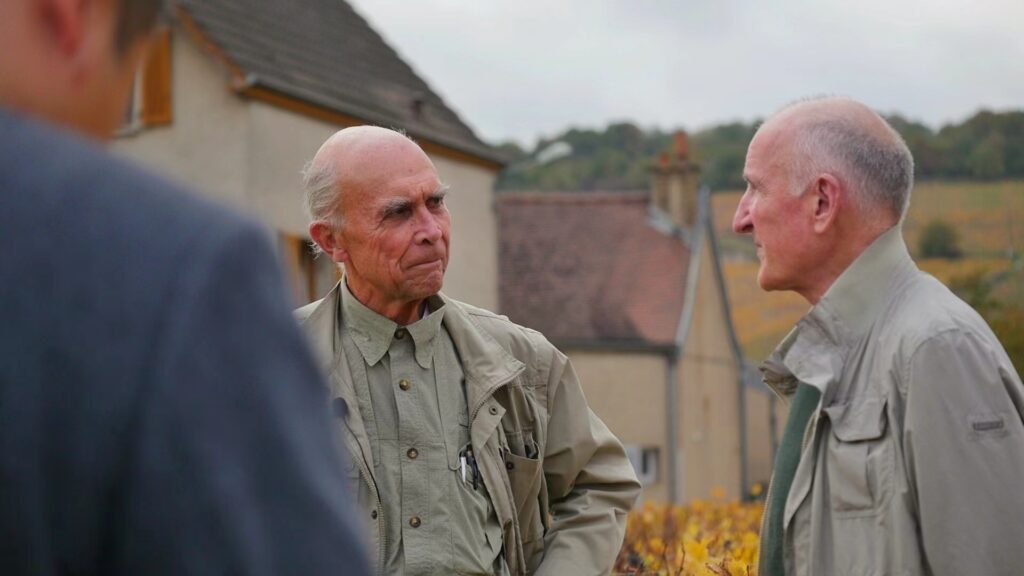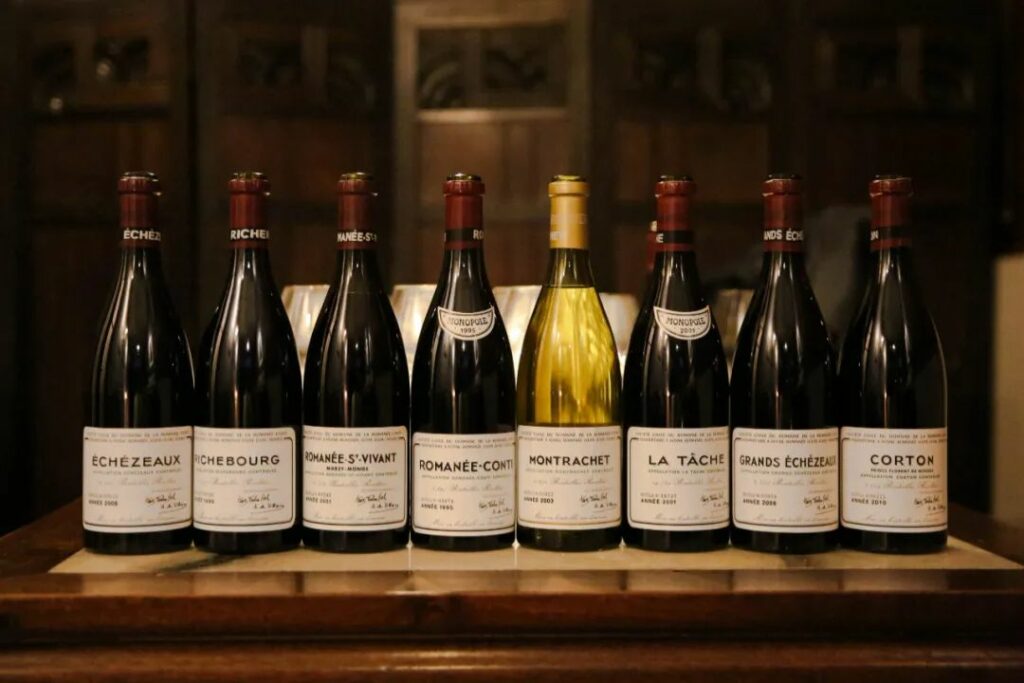Rapport de vendanges 2021- The 2021 harvest

The winter of 2020 was mild. In February, the cold weather returned and delayed the rise in sap. In the vineyard, nice dry weather set in which allowed us to do all the winter work quietly and perfectly. We were ahead everywhere, though the budburst started a little later than in recent years, at the end of March. So everything was going well at the beginning of the season. But that was without taking into account the fact that nature was preparing one of those lessons that she regularly gives us.
On the 6th, 7th and 8th of April, winter-like night frosts hit the vineyards – an attack crowned by a heavy snow shower during the night of the 7th which moistened the buds and left them defenseless to the frost. The damage was extremely serious throughout Burgundy.
In Vosne-Romanée, we have lost overall, if we take in account all our appellations, half a harvest. Our vineyards in Côte de Beaune were even more affected: in red Corton, we lost four fifths of a normal harvest, in Montrachet and in Corton-Charlemagne 90%. The rest of the season was not going to be any better with an extremely rainy and rather hot spring which made the vines grow with unprecedented speed. The work of lifting, disbudding and tying up was extremely disrupted, our team having great difficulty in keeping up with the rhythm imposed by these unseasonal weather conditions.
Diseases did not fail to appear: mildew and above all oidium which appeared in an unusually aggressive manner from May until the harvest. Botrytis was not to be outdone, appearing as early as July, but fortunately contained by the low temperatures. In September the rainy weather persisted, but gradually improved and we were lucky enough to harvest in good weather, from 23 September to 2 October, a harvest which was certainly damaged by frost and disease and which therefore required “haute couture” sorting, but whose maturity was finally satisfactory.

This difficult season has resulted in some of the lowest yields we have seen in 50 years:
– At Vosne-Romanée, globally around 15hl/ha, but with different situations: Romanée-Conti for example and Grands-Echezeaux gave us yields of 22 to 23hl/ha, the other appellations much less.
– In red Corton the yield is 4.5hl/ha. Exactly the same yield in Corton-Charlemagne.
– In Montrachet, instead of an average of 10 pieces, we produced 4 pieces, which is a yield of 7hl/ha.
In conclusion, a vintage that required as much work and effort as any other, if not more if you take into account the three nights spent lighting candles and fighting against frosts, but that’s part of the life of a winemaker. Satisfaction nevertheless: the quality of the wines is good. We find a style close to what we used to produce in the 1970s and 80s, that is to say less powerful wines, but on the other hand finer, more delicate and elegant than the last richer and more opulent vintages resulting from very ripe harvests. We can only hope that the vineyard, which has produced this year with a lot of pain, but in the end not so much, will want to make up for it next year and give us one of those beautiful harvests that fill the heart of the winegrower.

Rapport de vendanges 2022 – The 2022 harvest
What words can we find that are equal to all that we would like to tell and share when we have been lucky enough to experience the birth of a vintage as exceptional as 2022! Some might say that we would need a modern-day Virgil to write an ode to 2022… In fact, it is the vine itself which, this year, has written an ode to its own glory… the vine, this extraordinary plant, without equivalent in the plant world, which has shown once again, and more than ever, its resilience and its capacity to adapt to extremes.
Since the beginning of spring, drought and heat have made men and animals suffer, burned our gardens, crucified the trees in the forests… Exposed to the same extreme conditions, the vines remained green, without interruption, until the harvest. Our anxiety was maintained by the weather, we were afraid that the vine would cut itself off from its grapes to survive and leave them without juice or over-ripe, as we had seen it start to do in other very hot and dry years, such as 2003 for example… but no, on the contrary, it nourished its bunches to the end and delivered them to us full of juice and perfectly ripe. Today, three weeks after the last pruning and while the wines, finished, have just returned to the peace of the cellar, it is resting, perhaps even relieved, in a freshness that finally returned with the beginning of Autumn. The leaves are turning: each morning, the green still present, is mixed with a little more red… a little more copper… a little more gold… A miracle of the vine that blazes before going to sleep after giving birth to its fruit! It is a glorious autumn like never before which is preparing itself, the epilogue of a year which the word exceptional is not enough to qualify, so much the resilience of the vine throughout the season and the prodigious harvest which it delivered have no equivalent these last years.

If we must make comparisons, we can think of 2022 in terms of 2015… or 1999… years in which the vines experienced the same accomplishment, but, for us, 2022 evokes above all 1959, an unforgettable vintage, the only one whose quality/quantity ratio can be compared to 2022 and which marked the rebirth of Burgundy after the hundred or so years of misery that followed the arrival of phylloxera in the 19th century.
But let’s get back to our topic and try to tell the story of this adventure on the brink of the abyss, but ultimately triumphant, that was ours in 2022, and let’s try to list some of the factors that shaped and led to the success of this exceptional 2022 harvest. At the top of the list of these factors is the catastrophic frost that affected the whole of Burgundy in 2021 and led to a very small harvest. The vine was thus able to “store” unused reserves of food and energy which it was ready to use in 2022 if the climatic conditions were right. This is a fairly classic phenomenon in years following major climatic hazards and this is what happened in the form of a very significant “grape outflow” observed during budburst. The winter was not really cold or wet, although there were some frosty days and quite a lot of rain in December. Importantly, from April onwards, the heat and dryness lasted for a long time, which caused an early budburst and, consequently, the risk of frosts which fortunately had no effect. As a result of this favourable weather, the vegetation grew rapidly. For the vineyard teams, this made it very difficult to carry out work (pruning, disbudding, lifting, tying up, etc.) which normally follow one another, but this year they overlapped and forced us to work exceptionally quickly. Our vineyard managers, Nicolas Jacob and Didier Dubois, along with their troops were up to the challenge, but it was at the cost of very long working days. The same favourable conditions led to a very early and rapid flowering, which started on 20 May and was completed everywhere by 30 May. A very light and beneficial rain on 24 May accelerated the process. All the berries were fertilised and there was very little coulure. The number of bunches and the complete flowering of all the berries already announced an abundant harvest. Another result of this favourable weather: the usual vine diseases (mildew, powdery mildew, botrytis…) remained completely at bay and we were able to drastically reduce the number of phytosanitary treatments. June was hot, but significant rainfall occurred at the end of the month, including 75mm between 22 and 26 June. This rainfall, which helped the vines to overcome the heat waves that followed, was another key factor in the exceptional success of the vintage at Vosne-Romanée. July was extremely hot, with several heat waves, and not a single rainfall on the horizon. It was the same in August and, until the 15th, many vines were experiencing a blockage in ripening as a result of the excessive heat, a sign that the vines were in danger of closing in on themselves to survive, forgetting to ripen their grapes normally by photosynthesis. Then we were blessed with some thundery rains, from August 15th to 18th, which brought a total of 20mm: here lies another key factor in the success of the vintage, which explains why the heat and the drought did not block the ripening by photosynthesis of the grapes. The vines bore bunches that not only ripened normally, but also filled up with juice that we found at harvest time in a crop that, in terms of quantity, exceeded expectations. While we feared that the dry and very hot conditions would concentrate all the elements of the grape and that full ripeness, if reached, would be accompanied by little juice in the berries, in the end we had both, very high ripeness and a lot of juice. In these conditions, the progression of the said maturity, taking advantage of the beautiful days that followed the beneficial rain of August 15th, was extremely rapid until the harvest.

Reassured by this evolution, we took the risk of waiting until the maturities were very complete before deciding to start harvesting:
– The first vines to be picked were the red Corton, Clos du Roi, Bressandes and Renardes, on August 30
– La Romanée-Conti: on September 1
– Grands-Echézeaux: September 2, 3 and 4
– Le Montrachet: September 2
– La Tâche: September 4,5, and 6
– La Romanée-St-Vivant: September 7, 8 and 10 (the 9th was dedicated to rest)
– Vosne-Romanée Petits-Monts: September 10
– Echézeaux: September 11 12 and 13
– Corton-Charlemagne: September 8 and 13.
The harvest was long, lasting almost fifteen days, which is unusual and due to the exceptional quantity of magnificent grapes which, both white and red, arrived in the winery extremely healthy, without any trace of botrytis or any other disease. The few berries that had been burnt or slightly dried out by the sun were largely removed by the pickers in the vineyard, a task completed and refined on the sorting table. It has been a long time since we have seen our winery full to the brim without any empty vats! We are delighted and thank the gods and nature for having, in their benevolence, compensated for what they had taken away from us during the past year.
There are many lessons to be learned from the 2022 harvest. One of them is the importance of the plant material. At the harvest, we could see the difference between the vines, fortunately few in number here, bearing large, compact and heavy bunches and the fine vines which bore numerous bunches, but small, not very compact and with berries that were themselves small and thick-skinned. It is these berries that will give the 2022 all the richness, complexity and elegance that can already be seen in the wines that have just been drunk. Another lesson: the resilience of the vine, which remained green throughout the season and even after the harvest. We see this as a sign that it is beginning to adapt to the exceptional climatic conditions that we are experiencing and will experience, it seems, even more in the future. Without prejudging what will happen in the years to come, this 2022 vintage reinforces our confidence in the adaptability of Pinot Noir and Chardonnay here, provided they are fine types and married to good rootstock. In fact, this vintage has allowed us to evaluate more clearly than ever the adaptability of a particular rootstock, which will guide us in the future choices, which will be essential, of good rootstocks adapted to the extreme climatic conditions that we are likely to experience. Yet another lesson learned is the importance, as essential as ever, of choosing the right date to harvest. As we have written in previous reports, the success of a vintage depends of course on the joint work of nature and man throughout the year, but also on our risk-taking and, it must be said, on luck. We were very lucky, compared to others, not to have suffered frost, hail or any other major hazard. We took the risk by waiting for the grapes to be ripe, but not too ripe, in order to keep the right balance between the maturity of the sugar and the tannins and the freshness, that is to say to absolutely avoid over-ripe grapes which risk producing thick wines which are not Burgundian.

The wines are now finished and almost all of them are bottled. The vinification process was extremely peaceful and natural. The magnificent grapes vatted and the good evolution of the macerations allowed the winery team, led by Alexandre Bernier, to refine the vinification of each vat and each vintage in order to bring the expression of the magnificent harvest to its highest potential. The result is there: the colours are magnificent, the aromas already very developed and rich in perfume. On the palate, the tannins are supple, but above all, the freshness, finesse and elegance are surprising, given the climatic conditions of the year. They are proof, once again, of the adaptation of our Burgundian grape varieties to conditions different from those we experienced last century, but to which the vine’s genome, depending on the era, seems to have the capacity to adapt.
The white wines are still fermenting in barrels and tuns in the peace of the cellar. There was no berry shatter in our Montrachet and Corton-Charlemagne vines either, and they too produced beautiful quantities of perfectly ripe, golden grapes. Both climats benefited from scarce rainfall, but in roughly equal amounts, even if at different times. In both cases, the exceptionally thick skins of the berries protected the grapes from all attacks and it is very pure juice from perfectly healthy vines that is now finishing its fermentation.

 中文
中文



